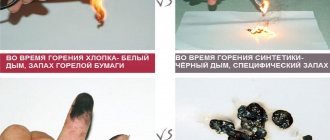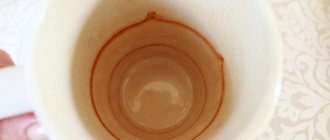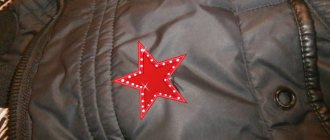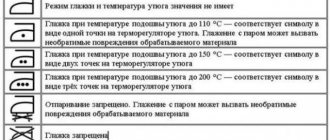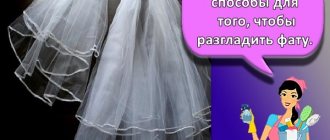General recommendations 1. Wash 2. Hot steam 3. Metal mug 4. Hair straightener 5. Wet towel 6. Vinegar and hair conditioner 7. Wet hands 8. Incandescent light bulb 9. Proper storage 10. Press 11. Dough rolling pin 12 . Household chemicals
The first irons of the 17th century were made entirely of metal, with hot coals placed inside. A little later, heating devices for ironing appeared - they were placed in the oven.
Do not miss
- Do not miss
How and with what to clean the iron from scale inside: 8 best products (video)
The electric analogue appeared at the end of the 19th century, it was invented by the American Henry Seeley. Today, every person has an iron. What to do if it breaks down or the power goes out? Take advantage of our life hacks.
How to prepare an ironing area
Virtuosos can get the perfect result on a table covered with a blanket, but it is better to have an ironing board.
For right-handers, it should be installed with the rounded end to the left, for left-handers, accordingly, to the right. The light should fall on the workplace from the side of the less active hand, the cord should freely follow the iron and not interfere with the ironer. It’s good to have gauze or a special ironing cloth and a container of water on hand. As a rule, modern irons are equipped with sprinklers, but a spray bottle will help moisten the item much faster.
Kettle with boiled water
This technique does not allow removing strong creases on clothes; it is more suitable for small folds. The procedure is quite simple, but can take a significant amount of time. Since ironing occurs under steam from boiled water from a kettle and lasts only a couple of minutes. To obtain the best result, this procedure is repeated up to 5-6 times. But, if there is no other possibility and it will bring results.
To do this, place a fold of the item under the spout of the kettle, where the steam comes from, and wait until it comes out. This method is especially popular on a business trip or vacation.
How to iron clothes
Shirts
For a good result, the shirt should not be dry. Before ironing, spray it with water from a spray bottle.
The shirt begins to be ironed from the collar. Iron it from the inside, then from the outside. The next stage is the cuffs. They should be unbuttoned and straightened on the ironing board, then ironed thoroughly. Then move on to the sleeves. They should not have arrows. To avoid accidentally ironing them, run the iron only along the middle of the sleeve, avoiding the folds of the fabric.
Lastly, iron the hems and back of the shirt. Pay special attention to the area where the loops are knocked out - after fastening the buttons, it will be on top.
Trousers
Turn the pants inside out and smooth out the seams and pockets. Further manipulations are carried out from the front side. To prevent shiny areas from appearing on your pant legs, use damp gauze. It will dry quickly from the heat of the iron, so keep a container of water handy.
Place one pant leg on a board, cover with gauze and iron from bottom to top.
Make sure that no creases form during the process; getting rid of them will not be easy.
Then take care of the top of the trousers; for convenience, you can pull them over the rounded edge of the board. Pay special attention to the folds at the waistband, if any.
The last stage is smoothing out the arrows. Align the side seams of the legs and carefully press the folds of the fabric through the gauze. This activity requires concentration, since a sloppy arrow looks sloppy than its absence.
Jackets
Due to the many seams and details, it is also better to iron a jacket or cardigan through gauze so that the fabric does not become shiny. Iron the sleeves first, then work on the shoulders. You can make the task easier by using a roller made from a tightly rolled towel. Place it in the sleeve to press the crease and under the shoulder to press the seams.
The back and shelf are also ironed from the front side through gauze. There should be no problems with the jacket, but the jacket will require special attention due to the darts on the chest. Make sure that folds do not form on the shelves if the designer has not provided for them. The collar and lapels are left as a “snack”. To make ironing easier, stretch the fabric a little with your hands as you go.
Knitwear
Knitwear should be treated with care even during the drying process. Items made from this material are best dried flat on a horizontal surface: then you may not have to iron them.
If the knitwear still needs ironing, moisten the item with water and gently steam it. There is no need to actively move the iron, just apply the hot sole of the device to each area of the item and stay in this position for a few seconds. This way you do not deform the knitted product.
Delicate items
It is better to iron items made from thin fabric from the inside out at the lowest temperature setting. First, try ironing an area of the item that is not in sight: this way you will understand how the fabric will behave after contact with a hot surface. You can also save a scrap of fabric, which is often sewn onto the garment, and practice ironing the delicate fabric on it.
Ironing different types of fabrics
The composition of the fabric determines at what temperature you need to iron things made from it, as well as other processing features. Purchased clothing always has a label with care instructions.
Natural
To iron things quickly and efficiently, you need to follow certain recommendations. One of them is the right temperature. This parameter depends on the type of fabric:
| Fabric type | Ironing temperature, °C | Ironing recommendations |
| Cotton | 180-220 | Do not dry or dampen when ironing |
| Linen | 215-240 | Iron through a damp cloth or spray with a spray bottle. If the item is starched, reduce the temperature |
| Velveteen | 100 | Iron dry from the inside out or through the fabric from the front side. Ironing wet or overdried corduroy is difficult. |
Synthetics
Features of ironing synthetics depend on the composition of the fabric. The general recommendation is a temperature of up to 115°C, although for some products it may be higher. Viscose is ironed at 150-180°C, for polyester it is set at 140-155°C.
Important! If the fabric is mixed, then to determine the ironing temperature, all its components are taken into account. Select the smallest parameter.
Delicate wool and silk
You can iron silk items at a temperature of 140-165°C; usually a separate mode is provided for such fabric. The product is ironed exclusively from the inside out through a damp cloth.
A silk item may be slightly under-dried, but it is not sprayed with a spray bottle. There is a risk of stains.
Wool can be ironed at 160-170°C. Iron things from the inside out through a dampened fabric. You need to act quickly, without staying in one area for more than 2-3 seconds. When ironing, it is important not to stretch the fabric. It is permissible to steam woolen products.
It is better not to iron mohair at all, as things lose their fluffiness. The fabric is smoothed out with proper horizontal drying.
How to iron home textiles
Sheets with elastic
Ironing a sheet with an elastic band around the perimeter is not for the faint of heart. It is not clear how to fold it and place it on the ironing board.
You can iron the sheet immediately before use. Pull it onto the mattress and run the iron over it. If the issue of storing ironed bed linen is important, you can iron the sheet on the mattress, then carefully roll it up. Fold it in half and tuck one corner into the other on each side, then in half again so that all corners are aligned. Spread the resulting rectangle on the table and fold it like a traditional sheet.
Duvet covers
Fold the duvet cover into quarters. Iron on one side, turn over and repeat the procedure. Unfold the duvet cover and fold it again so that the unironed sides are on the outside. Iron again on both sides. Repeat until all the fabric is straightened.
Silk bed linen
It is better to iron silk from the inside out so as not to damage the delicate fabric. Be sure to keep the labels that indicate what ironing temperature the manufacturer recommends using for the product, and strictly follow these tips.
It is not recommended to spray silk linen with water while ironing: streaks may remain.
If there is a need to moisten the item, it is better to spray it with a spray bottle and put it in a plastic bag for an hour. This way the product will be evenly saturated with moisture.
Tablecloths
Iron the edge first, then move on to the center part. If the product is very dry, spray it with a spray bottle and roll it up so that it is moistened evenly. For cotton and linen tablecloths, use hot water; its fabric absorbs better.
Curtains
Curtains should be ironed when they are still damp. Start ironing the curtain from top to bottom. When the top edge drops from the ironing board almost to the floor, hang the curtain on the curtain rod. Continue stroking the bottom, smoothing it out onto the board. This way you will avoid creases and contamination of the fabric. Lambrequins can also be ironed while wet.
For synthetic fabrics, there is a life hack that will allow you to do without an iron altogether. Hang damp curtains on the curtain rod - they will smooth out under their own weight.
Useful tips
Things that contain synthetics wrinkle much less. These are the clothes you should take with you on the road. At least a few percent of synthetic fibers in the material will prevent clothes from becoming too wrinkled in a suitcase or after washing.
Be sure to shake the laundry vigorously after washing and before hanging it up. Things are hung evenly on the rope, straightening out all the folds and creases. Then you won’t have to carefully iron your clothes.
To make things less wrinkled in a suitcase, they need to be folded correctly. It is best to roll up the clothes. Then it will wrinkle much less and take up less space in your travel bag.
If the product is washed by hand, it should not be wrung out too much, much less twisted. It is better to let the water drain away when the clothes are hung on the rope.
If you are thinking about buying an ironing device, then today there are excellent alternatives to the classic iron. Many housewives refuse traditional ironing and choose steamers. Steamers work simply: water boils in a boiler and steam is supplied through a hose.
The steamer is very convenient for ironing large items - suits, jackets, heavy dresses and shirts will become perfectly ironed in a couple of minutes. Things can be laid out or steamed while hanging.
In addition, using a steamer you can clean upholstered furniture, disinfect your home, and kill pests.
As you can see, there are quite a lot of ways to iron pants, and any underwear in general. If you don’t have an iron at hand, choose one of the options and get ready to go out!
How to iron things that shouldn't be ironed
If the label on the item clearly prohibits contact of the fabric with the iron, but folds and creases need to be smoothed out somehow, there are two ways to solve the problem.
Ironing with obstacles
You will need four thick napkins. Moisten two of them. Fold a “sandwich”: a wet napkin, a dry one, then a crumpled item, then a dry napkin and a wet one again. Iron the design with a low-heat iron.
Steaming
Hang the product on a hanger or lay it out on a board. Bring the iron to the fabric, but do not touch it with a hot surface. Check the device in advance: along with the steam, it may begin to spew out pieces of rust. Press the steam button until the item becomes slightly damp. Then let it cool and dry.
Pot of water
This procedure made it possible to straighten clothes not completely, giving preference to shallow creases in them. To do this, water was boiled in a saucepan and the item of clothing was kept over it for some time. This way it was possible to smooth out some of the wrinkles in the clothes and freshen them up.
Interesting! Just like 50 years ago, brides still use the steam method to iron their wedding dresses. Since the fabric of a wedding dress is very delicate and easily damaged by a simple iron.
Another very interesting and little-known method involves using a teapot.
Mechanical impact
The ancient Romans straightened washed clothes using a wooden press; in Russia, shirts were wound on a roller and rolled with a ruble. These ancient devices are based on the principle of mechanical pressure on fabric. Nowadays, it is also possible to “iron” a shirt, T-shirt, dress or T-shirt using methods based on pressure on the fabric.
- Dry “crease-free” in an automatic washing machine. Modern models perform this function. To achieve the desired result, set the spin program at maximum speed. In emergency cases, you can use this method, but you should not use it regularly. When exposed to large centrifugal forces, the fibers of things stretch, and the material wears out quickly.
- Pressing. It is acceptable only if the ironed item is needed the next morning. The crumpled product is placed on the base of the bed, carefully leveled by hand, and covered with a mattress. When you take out your shirt in the morning, you will be pleasantly surprised by the absence of deep creases, folds and even small wrinkles.
- Putting on under-dried clothes. This method is good for a tight-fitting shirt, jacket, blouse or skirt. Here, in addition to mechanical tension, the thermal effect of the body is added, which helps dry and smooth the fabric.
Curtains
Don't want to draw your guests' attention to the crumpled curtains on the windows? Then you need to devote time to ironing them, although this task is not an easy one, but, as you know, nothing is impossible. Cotton and polyester fibers require careful care, otherwise they are easily damaged, thereby compromising the integrity of the fabric.
Set your steam iron to its lowest setting. If it is high, there is a high probability that the fabric will burn or will not look aesthetically pleasing. Iron curtains while hanging. If you don’t have such a device, hang them on a curtain rod and then start steaming. A steam generator can be an excellent alternative to an iron; moreover, using it, the likelihood of damaging the fabric is much lower.
Leather
Steam treatment of leather is particularly effective, resulting in a product that looks like new. This is done as follows: hot water is drawn into the bath, after which the product is hung above it, but so that it does not touch the water. You can also use low-power handheld steamers, which are often used in clothing stores. If you don't have it, a regular iron with a steam function will do.
Rare shot: Viktoria Isakova showed her grown-up daughter from Yuri Moroz (new photo)
Lost weight: what Sofia Tarasova sacrificed for the sake of “VIA Gra” (new photos)
Smooth and fresh skin: dermaplaning, or why a woman needs to shave her face
It is not recommended to smooth leather products with the soleplate of an iron, but there are cases when this is quite acceptable. The minimum heating temperature is set on the device, the product itself is covered with kraft paper (it is used for pasting cardboard furniture or homemade furniture) or chintz fabric, after which they begin ironing. It is important to do this very carefully so as not to touch the skin. If the garment has a lining, it is better to iron it from the wrong side. In this case, using the steaming function is not recommended.
Immediately after ironing is completed, the product is hung on a hanger; it is not advisable to put on a freshly ironed item; you need to give it 10-15 minutes to cool.

